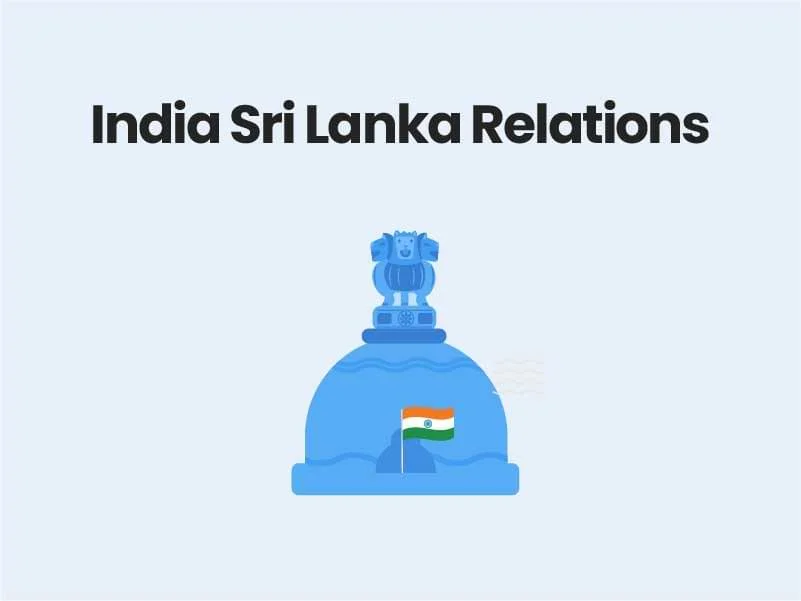
India Sri Lanka Relations
The relationship between India and Sri Lanka is more than 2,500 years old. Both countries have a legacy of intellectual, cultural, religious and linguistic interaction. In recent years, the relationship has been marked by close contacts at all levels. Trade and investment have grown and there is cooperation in the fields of infrastructure development, education, culture and defence.
- In recent years, significant progress in implementation of developmental assistance projects has further cemented the bonds of friendship between the two countries.
- The nearly three-decade long armed conflict between the Sri Lankan forces and the LTTE came to an end in May 2009. During the course of the conflict, India supported the right of the Sri Lankan Government to act against terrorist forces.
- India’s consistent position has been in favour of a negotiated political settlement, which is acceptable to all communities within the framework of a united Sri Lanka and is consistent with democracy, pluralism and respect for human rights.
- In 1987, the Indo-Sri Lankan accord also called the Rajiv Gandhi-Jayewardene accord was signed. It sought to give autonomy to the provinces of North and East where the Tamil population was in majority. This accord though could not be implemented.
- However, one of the provisions of this accord was implemented. It was the 13th amendment to the Sri Lankan constitution. Before this amendment, Sri Lanka had a unitary polity. This Amendment Act provided for federalism. It established Provincial Councils and introduced Tamil and Sinhalese as the national languages of Sri Lanka and provided for English as the link language.

Economic Cooperation and Development Assistance
- Sri Lanka has long been a priority destination for direct investment from India. Sri Lanka is one of India’s largest trading partner in SAARC
- Trade between the two countries grew particularly rapidly after the entry into force of the India-Sri Lanka Free Trade Agreement in March 2000.
- Bilateral trade in 2018 amounted to US $ 4.93 billion. Exports from India to Sri Lanka in 2018 were US$ 4.16billion, while exports from Sri Lanka to India are US$ 767 million.
- India is one of the largest investors in Sri Lanka with cumulative investments of around USD 1.239 billion. Last few years have also witnessed an increasing trend of Sri Lankan investments into India
- Sri Lanka is among the major recipients of development assistance from the Government of India. India’s overall commitment stands close to US$ 3 billion, out of which around US$ 560 million are purely in grants.
- The two nations are part of the Asian Tea Alliance which also has China, Japan and Indonesia, the other two important manufacturers of tea in the Asian continent.
Debt Problem of Sri Lanka
- It is estimated that Sri Lanka’s total external debt is around USD 60 billion
- China, which regularly indulges in debt trap diplomacy, has already taken over the Hambantota Port from Sri Lanka for a 99-year lease. This was done due to non-repayment of loan.
- Countries like Srilanka, Surrendering national strategic assets to China is becoming a security threat to India as well.
Read GS Full Notes
Defence and Strategic Relations:
- Two navies participate in the SLINEX bilateral naval exercises. The two Armies participate in the Mitra Shakti bilateral exercises.
- Srilanka plays a major role in India’s ambition towards NET SECURITY PROVIDER IN THE IOR.
- Srilanka is considered as a strategic location to monitor the International Sea Lanes of Communication.
- The Hambantota port to which China had access is considered as the String of Pearls initiative developed by China to contain India’s strategic Growth.
- India and Srilanka participates in various international organisations such as SAARC, BIMSTEC etc.
Cultural Relations
- The People of Indian Origin (PIOs) comprise Sindhis, Gujaratis, Memons, Parsis, Malayalis and Telugu speaking persons who have settled down in Sri Lanka and are engaged in various business ventures.
- The Cultural Cooperation Agreement has been signed between both the countries.
- Buddhism is a connecting link between India and Sri Lanka on religious lines.
- Education is another important area of cooperation between India and Sri Lanka. India offers scholarship slots annually to deserving Sri Lankan students.
- Tourism also forms an important link between India and Sri Lanka. India is the largest source of market for Sri Lankan tourism.

Issues in India-Sri Lanka Ties
- The Death of Indian Fishermen: Many fishermen from the state of Tamil Nadu cross the maritime boundary to catch fish. It is generally believed that the catch is more prosperous on the Sri Lankan side. In January 2021, Sri Lanka reacted violently and their navy fired upon these fishermen and killed them on the spot.
- Indian boats have been fishing in the troubled waters of Palk Strait and the Gulf of Mannar for centuries.
- In 1974 and 1976 treaties were signed between the two countries to demarcate the International Maritime Boundary Line (IMBL).
- However, the treaties failed to factor in the hardship of thousands of traditional fishermen who were forced to restrict themselves to a meagre area in their fishing forays
- Fishermen often risk their lives and cross the IMBL rather than return empty-handed.
- To deal with the issue of detention of fishermen in a humane manner, India and Sri Lanka have set up a Joint Working Group (JWG) on Fisheries as the mechanism to help find a permanent solution
Cancellation of the ECT Project at the Colombo Port
- Sri Lanka has unilaterally pulled out of a 2019 agreement with India and Japan for developing the strategic East Container Terminal (ECT) at the Colombo Port.
- India was disappointed with the decision as over 70 per cent of the transshipment business in the terminal is linked to India. Moreover, it is also of geostrategic interest for India, as the terminal is located in proximity to Colombo Port City, being developed by the Chinese. Both India and Japan officially expressed their disappointment with the decision.
Jaffna Hybrid Energy Project
- The MS/Sinosolar-Etechwin joint venture (JV) was awarded the contract to install a hybrid renewable energy system on Nainativu, Delft, and Analaitivu islands off the Jaffna Peninsula.
- Citing security concerns, India registered a protest over the selection of the Chinese company to execute the project. A group of Sri Lankan Tamil leaders also objected to the project, noting India’s security concerns.
Issues of Tamilians in Srilanka
- Denial of Citizenship: The problem of the Srilankan Tamils began earlier than the 1950s. After independence in 1948 the Srilankan government felt that the Tamils were not Srilankan because they had Indian ancestry.
- Linguistic Discrimination: The conflict between Sinhalese and Tamils in Sri Lanka started in 1956 when Sinhala was made the official language by the country’s President and large scale discrimination began against the Tamils.
- Religious Discrimination: The discrimination against the Tamil population continued throughout the 1960s as Buddhism was given the primary place in the state.
Liberation Tigers of Tamil Eelam (LTTE): It was formed in 1976 as the self-styled “national freedom movement of the people of Tamil Eelam” and began a guerilla war on the government and administration.
Enroll today with the best civils service academy and take your first step towards your Civils journey.
Feel free to reach out to us for any inquiries, collaborations, or support. We’re here to help.

